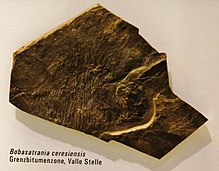Bobasatraniais anextinctgenusof prehistoric marineray-finned fishthat survived thePermian-Triassic extinction event.Fossils ofBobasatraniawere found in beds ofChanghsingian(late Permian) toLadinian(Middle Triassic) age.[1][2]It was most speciose during theEarly Triassic.[3]
| Bobasatrania Temporal range:
| |
|---|---|

| |
| Bobasatrania canadensisfossil | |

| |
| Bobasatrania canadensisrestoration | |
| Scientific classification | |
| Domain: | Eukaryota |
| Kingdom: | Animalia |
| Phylum: | Chordata |
| Class: | Actinopterygii |
| Order: | †Bobasatraniiformes |
| Family: | †Bobasatraniidae |
| Genus: | †Bobasatrania White,1932 |
| Type species | |
| †Bobasatrania mahavavica White,1932
| |
| Species | |
|
See text | |
| Synonyms | |
The genus was named after the locality Bobasatrana (nearAmbilobe) in northeastMadagascar,from where thetype species,Bobasatrania mahavavica,was described. The name of this species refers to theMahavavy River.[4]




Taxonomy
editThe following species are known:[1][2]
- †B. antiqua(Accordi, 1955)- Latest Permian of Italy
- †B. canadensis(Lambe,1914)-Early Triassic(Olenekian) ofBritish Columbia
- †B. ceresiensisBürgin, 1992- Middle Triassic (Ladinian) of Switzerland
- †B. groenlandicaStensiö,1932- Earliest Triassic ofGreenland
- †B. ladina(Accordi, 1955)- Latest Permian or earliest Triassic of Italy
- †B. mahavicaWhite,1932- Early Triassic of Madagascar
- †B. moroderi(Accordi, 1955)- Latest Permian of Italy (possibly conspecific withB. antiqua)
- †B. nathorsti(Stensiö,1921)- Earliest Triassic ofSvalbard
- †B. scutata(Gervais, 1852)- Middle Triassic (late Ladinian) of Germany and France
Remains of indeterminate species are known from the earliest Triassic of both Australia (found via drill core) and theSalt RangeofPakistan,as well as the later Early Triassic of the US states ofNevadaandIdaho.[2]
The remains of a "Platysomus"-style tooth plate known from the latest Carboniferous or earliest Permian of the United States appear to be the earliest record of aBobasatraniarelative.[2]
Occurrence
editBobasatraniaprobably originated during theLopingian(latePermian)epoch,survived the Permian-Triassic extinction event, and underwent aspeciationevent during theTriassicin the shallow coastal waters off thePangaeansupercontinent. Theirfossilsare therefore found across the globe (Canada, France, Germany, Greenland, Italy, Madagascar,Spitsbergen,Pakistan, Switzerland, United States).[2][5][6]Some of the best examples are known from the Wapiti Lake region ofBritish Columbia, Canada.[7]The geologically oldest fossils are from the latest PermianBellerophon Formationof Italy, while the youngest are from the late LadinianMuschelkalkof Germany and France. Fossils include complete specimens but also isolated, characteristic tooth plates.[2]
Appearance
editThey have a distinctive diamond-shaped body, forked tail and long thinpectoral fins.B. ceresiensiswas about 25 cm (9.8 in) long,[8]while other species, such asB. canadensis,grew to about 1.2 m (3.9 ft) in length or larger.[9][10]The structure of their teeth (tooth plates) suggests they fed on shelled animals.
See also
editReferences
edit- ^ab"PBDB".paleobiodb.org.Retrieved2024-03-19.
- ^abcdefBöttcher, Ronald (2014-11-01)."Phyllodont tooth plates of Bobasatrania scutata (Gervais, 1852) (Actinoperygii, Bobasatraniiformes) from the Middle Triassic (Longobardian) Grenzbonebed of southern Germany and eastern France, with an overview of Triassic and Palaeozoic phyllodont tooth plates".Neues Jahrbuch für Geologie und Paläontologie - Abhandlungen.274(2–3): 291–311.doi:10.1127/njgpa/2014/0454.ISSN0077-7749.
- ^Romano, Carlo; Koot, Martha B.; Kogan, Ilja; Brayard, Arnaud; Minikh, Alla V.; Brinkmann, Winand; Bucher, Hugo; Kriwet, Jürgen (February 2016). "Permian-Triassic Osteichthyes (bony fishes): diversity dynamics and body size evolution".Biological Reviews.91(1): 106–147.doi:10.1111/brv.12161.PMID25431138.S2CID5332637.
- ^White, Errol Ivor(1932). "On a new Triassic Fish from North-East Madagascar".Annals and Magazine of Natural History.Series 10.10(55): 80–83.doi:10.1080/00222933208673541.
- ^Nielsen, Eigil.(1952)."A preliminary note onBobasatrania groenlandica"(PDF).Meddelelser Fra Dansk Geologisk Forening.12(2): 197–204.
- ^Bürgin, Toni (1992). "Basal ray-finned fishes (Osteichthyes; Actinopterygii) from the Middle Triassic of Monte San Giorgio (Canton Tessin, Switzerland)".Schweizerische Paläontologische Abhandlungen.114:1–164..
- ^"Past lives: Chronicles of Canadian Paleontology - Triassic fishing".Archived fromthe originalon 2009-12-21.Retrieved2009-11-13.Past Lives: Chronicles of Canadian Paleontology
- ^Rieppel, Olivier (2019).Mesozoic Sea Dragons: Triassic Marine Life from the Ancient Tropical Lagoon of Monte San Giorgio.Indiana University Press. p. 116.doi:10.2307/j.ctvd58t86.ISBN978-0253040114.S2CID241534158.
- ^Russell, Loris S. (1951). "Bobasatrania?canadensis(Lambe), a giant chondrostean fish from the Rocky Mountains ".Annual Report of the National Museum of Canada, Bulletin.123:218–224.
- ^Neuman, Andrew G. (2015). "Fishes from the Lower Triassic portion of the Sulphur Mountain Formation in Alberta, Canada: geological context and taxonomic composition".Canadian Journal of Earth Sciences.52(8): 557–568.Bibcode:2015CaJES..52..557N.doi:10.1139/cjes-2014-0165.
Further reading
edit- Nielsen, Eigil. 1942. Studies on Triasslc Fishes from East Greenland. I.GlaucolepisandBoreosomus.Palaeozoologica Groenlandica.vol. I.
- Nielsen, Eigil. 1949. Studies on Triassic Fishes from East Greenland. II.AustralosomusandBirgeria.Palaeozoologica Groenlandica.vol. III. 204 Medd, fra Dansk Geol. Forening. København. Bd. 12. [1952].
- Stensiö, E. A:EON, 1921. Triassic Fishes from Spitsbergen. Part I. Vienna.
- Stensiö, E. 1932. Triassic Fishes from East Greenland. Medd. om Grønland, Bd. 83, Nr. 3.
- Stensiö, E. 1947. The sensory Lines and dermal Bones of the Cheek in Fishes and Amphibians. Stockholm, Kungl. Sv. Vet. Akad. Handl., ser. 3, Bd. 22, no. 1.
- Watson, D. M. S., 1928. On some Points in the Structure of Palaeonlscid and allied Fish. London, Zool. Soc. Proc, pt. 1.